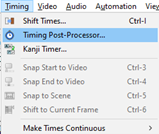This article delineates a stringent protocol for the temporal alignment of subtitles in relation to cinematographic shot transitions, principally within the milieu of 24fps media. It promulgates a non-straddling principle for subtitle transitions, save for enumerated exceptions under specified auditory and visual thresholds. A bifurcated methodological approach is prescribed for determining both the cessation and commencement of subtitle overlays contingent on the temporal proximity of auditory cessation to visual shot demarcation. Elaborations include a dualistic stratagem for subtitles that either precede or straddle the auditory threshold relative to the visual shot transition, necessitating precise frame-specific adjustments. Furthermore, the article canvasses the conditions under which exceptions to the non-straddling rule may be operationalized, notably in contexts where sequential dialogue continuity overrides the conventional segmentation prompted by shot transitions. Additional stipulations encompass maximum character rates per second, the prescribed duration of subtitle visibility, and anti-flicker measures to obviate ocular strain. While the proposed systematization is labour-intensive, it is deemed essential for formal subtitling endeavours; nonetheless, expedient methodologies employing post-processing tools such as Aegisub are acknowledged for their utility in less formal subtitling contexts, despite potential compromises in viewer discernment. This article thus offers an erudite framework for the temporal orchestration of subtitles, reconciling the imperatives of linguistic clarity with cinematographic integrity.
How to Respect Shot Changes
- Whenever possible, subtitles shall not straddle shot changes. (exceptions listed below)
Point 2 & 3 below ensure subtitles’ synchrony with shot changes, instead of lagging, or dragging forward them. Elaborations below deal with 24 fps contents, do necessary conversions if needed.
- When a shot ends, there are two suggested methods to determine the corresponding subtitle’s out-time, catering for two circumstances, respectively.
- The speaker stops talking before the shot change, leaving a silent interval of more than 1/2s (12 frames for 24fps,) to the shot changing frame. In this case, set the subtitle’s out-time to at least 12 frames before the shot changing frame.
- If the speaker’s voice lasts to the end of the shot, or straddles to the next shot, taking up less than 12 frames, set the corresponding subtitle’s out-time to be exactly the same as the last frame of the first shot.
An Elaborative Graph:

- When a new shot comes in, there are also two suggested methods to determine the corresponding subtitle’s in-time, catering for two circumstances, respectively.
- The speaker starts talking more than 12 frames later than the shot changing frame. In this case, set the subtitle’s in-time to at least 12 frames after the shot changing frame.
- The speaker starts talking less than 12 frames after the shot change, or less than 12 frames prior to the shot change. In this case, set the subtitle’s in-time to exactly one frame after the shot changing frame. (some official translations/fan subbing groups prefer not to keep the one-frame blank after the shot change, rather, they choose to leave one/two blank frames before the shot change, I am personally against that)
An Elaborative Graph:

- Special Circumstances:
Generally, it is suggested to wait for scene changes to subtitle speakers, and reset subtitles whenever a shot ends. If a straddle has to be made, consider the following prerequisites — A subtitle needs to simultaneously satisfy all following conditions for it to be eligible for straddling shots:
- The voice of it starts more than 12 frames prior to the shot change [or] extends to the next shot, taking up more than 12 frames.
- Not straddling it will incur violation of Rule II [or] will cause saliently discernible scene-voice asynchrony, which even surmounts the shot changes’ fundamental function of giving grounds to (or identifying) different speakers.
- Straddling it will not take up too much time of the next subtitle. (i.e., the straddling mustn’t cause the next subtitle to violate Rule II)
Special Circumstance I: If c) is the only prerequisite that cannot be satisfied, it is then highly suggested to coalesce the subtitle and its next one (preferably spoken by two speakers) into one dual-line subtitle. Once they are coalesced, straddling without satisfying c) will be permissible.
Special Circumstance II: If any subtitle necessitates conflation with its previous/next (go with the more natural one) line for meeting the min duration requirement, a dual-line subtitle may also be used, and therefore be eligible for straddling, even if none of them alone needs the straddling.
Word Rate & Max/Min Duration (Conventionally)
Maximum word rate: Chinese – Up to 9 ch/s; English – Up to 20 ch/s (controversial)
Max duration: 7 seconds per subtitle event; Min duration: 5/6 seconds (20 frames for 24 fps).
Anti-flicker
When timing a sequence of subtitles, delay the out-time of the previous subtitle to two frames (regardless of frame rates) before the in-time of the new subtitle where any gaps of fewer than half a second exist. This is sometimes known as “chaining” or “closing gaps”. (from Netflix)
More Concisely: (from Netflix)
- Subtitles must have a minimum of 2 frames between them. This parameter is applicable to any frame rate of content.
- In 24fps content, any gaps between subtitles of 3-11 frames inclusive must be closed to 2 frames. (do necessary frame conversions if you need)

The above procedure is super time-consuming, so traditionally, in fan subbing groups, when dealing with those not-so-formal projects, it is acceptable to simply use the Timing Post-Processorin Aegisub to simply link subtitles between which the gaps are less than 12 frames together. But this shortcut may make it difficult for the viewers to discern line changes, especially when lengths of the two lines are similar, so avoid using it when dealing with formal tasks.









Comments | NOTHING